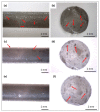The Influence of Graphene Content on the Antibacterial Properties of Polycaprolactone
- PMID: 36142811
- PMCID: PMC9500631
- DOI: 10.3390/ijms231810899
The Influence of Graphene Content on the Antibacterial Properties of Polycaprolactone
Abstract
This work contains an analysis of the impact of modifying a bioresorbable polymer-polycaprolactone (PCL)-with various additives on its antibacterial properties. To this end, samples of PCL filament containing various content levels of graphene (GNP), 0.5%, 5%, 10%, were obtained using injection molding. Polymer samples without additives were used for comparison. The next step was to assess the antimicrobial impact of the preparations under study against the following microorganisms: Staphylococcus aureus ATCC 25293, Escherichia coli ATCC 25922, Candida albicans ATCC 10231. Effective bactericidal activity of PCL with small amount of GNP, especially against C. albicans and S. aureus was confirmed. A decrease in this property or even multiplication of microorganisms was observed in direct proportion to the graphene content in the samples.
Keywords: antibacterial; biomaterials; graphene; polycaprolactone.
Conflict of interest statement
The authors declare no conflict of interest.
Figures








Similar articles
-
Analysis of the antibacterial properties of polycaprolactone modified with graphene, bioglass and zinc-doped bioglass.Acta Bioeng Biomech. 2021;23(2):131-138. Acta Bioeng Biomech. 2021. PMID: 34846034
-
A promising poly (e-caprolactone)/graphene-based scaffold as an antibacterial in regenerating bone tissue.Braz J Biol. 2024 Aug 12;84:e279967. doi: 10.1590/1519-6984.279967. eCollection 2024. Braz J Biol. 2024. PMID: 39140500
-
Discovery of quinolinequinones with N-phenylpiperazine by conversion of hydroxyquinoline as a new class of antimicrobial agents targeting resistant pathogenic microorganisms.Bioorg Chem. 2022 Nov;128:106045. doi: 10.1016/j.bioorg.2022.106045. Epub 2022 Jul 21. Bioorg Chem. 2022. PMID: 35921788
-
Ultrasound irradiation: a robust approach for direct functionalization of graphene oxide with thermal and antimicrobial aspects.Ultrason Sonochem. 2014 Jul;21(4):1407-16. doi: 10.1016/j.ultsonch.2014.02.022. Epub 2014 Feb 28. Ultrason Sonochem. 2014. PMID: 24613466
-
Graphene in nanomedicine: A review on nano-bio factors and antibacterial activity.Colloids Surf B Biointerfaces. 2023 Jun;226:113323. doi: 10.1016/j.colsurfb.2023.113323. Epub 2023 Apr 20. Colloids Surf B Biointerfaces. 2023. PMID: 37116377 Review.
Cited by
-
Biomaterials Adapted to Vat Photopolymerization in 3D Printing: Characteristics and Medical Applications.J Funct Biomater. 2023 Dec 22;15(1):7. doi: 10.3390/jfb15010007. J Funct Biomater. 2023. PMID: 38248674 Free PMC article. Review.
-
Is Silver Addition to Scaffolds Based on Polycaprolactone Blended with Calcium Phosphates Able to Inhibit Candida albicans and Candida auris Adhesion and Biofilm Formation?Int J Mol Sci. 2024 Feb 28;25(5):2784. doi: 10.3390/ijms25052784. Int J Mol Sci. 2024. PMID: 38474027 Free PMC article.
-
3D-Printed Polycaprolactone Implants Modified with Bioglass and Zn-Doped Bioglass.Materials (Basel). 2023 Jan 25;16(3):1061. doi: 10.3390/ma16031061. Materials (Basel). 2023. PMID: 36770074 Free PMC article.
-
Antimicrobial properties of Graphene sheets embedded with Titanium Oxide and Calcium Oxide nanoparticles for industrial wastewater treatment.Sci Rep. 2025 Jan 6;15(1):1007. doi: 10.1038/s41598-024-84335-x. Sci Rep. 2025. PMID: 39762454 Free PMC article.
-
Tuning of Silver Content on the Antibacterial and Biological Properties of Poly(ɛ-caprolactone)/Biphasic Calcium Phosphate 3D-Scaffolds for Bone Tissue Engineering.Polymers (Basel). 2023 Aug 31;15(17):3618. doi: 10.3390/polym15173618. Polymers (Basel). 2023. PMID: 37688244 Free PMC article.
References
-
- Yang Y., Yan H., Kang X., Zhibin Z. Advances in Application Research of Polycaprolactone. New Chem. Mater. 2011;39:13–15.
-
- Chen D.R., Bei J.Z., Wang S.G. Polycaprolactone microparticles and their biodegradation. Polym. Degrad. Stabil. 2000;67:455–459. doi: 10.1016/S0141-3910(99)00145-7. - DOI
MeSH terms
Substances
Grants and funding
LinkOut - more resources
Full Text Sources

